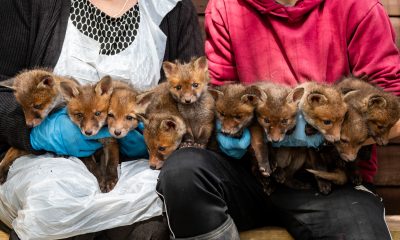Research claims climate change could spark the next pandemic
"At least 15,000 new cross-species viral sharing events are projected by 2070."
Published
2 years ago onBy
Talker NewsBy Mark Waghorn via SWNS
Climate change could spark the next pandemic by pushing different types of wildlife closer to where humans live, according to new research from DC.
This ecological shift will increase the risk of 'zoonotic spillover' - viruses that are transmitted to people, new research revealed.

Loss of habitat forces animals to migrate and potentially come into contact with other species, leading to an increase in the number of germs spreading to humans.
They predict that at least 15,000 new cross-species viral transmissions will occur - within the next 50 years.
The finding is based on the first comprehensive assessment of how global warming will restructure the mammalian virome - viruses that infect host cells.
It focused on geographic range shifts - journeys undertaken to relocate into areas likely to have large human populations.
As they encounter other mammals for the first time, the study projects they will share thousands of viruses.
These shifts will bring greater opportunities for viruses like Ebola or coronaviruses to emerge in new regions - making them harder to track.
They will emerge in new types of animals - leading to viruses jumping across a 'stepping stone' species into humans.
A similar phenomenon is believed to be behind COVID-19 - which originated in bats.

(Altrendo Images/Shutterstock)
Lead author Professor Colin Carlson, of Georgetown University in Washington DC, said: "The closest analogy is actually the risks we see in the wildlife trade.
"We worry about markets because bringing unhealthy animals together in unnatural combinations creates opportunities for this stepwise process of emergence - like how SARS jumped from bats to civets, then civets to people.
"But markets aren't special anymore; in a changing climate, that kind of process will be the reality in nature just about everywhere."
Animal habitats will move disproportionately in the same places as human settlements - creating new hotspots of spillover risk.
The process could already be underway in today’s 1.2 degrees warmer world - and efforts to reduce greenhouse gas emissions may not stop these events from unfolding.
Worryingly, the study found rising temperatures will have the most impact on bats - which account for most spillovers of disease.
Their ability to fly will allow them to travel long distances - and share the most viruses. Africa is most vulnerable along with Asia - a global hotspot of bat diversity.
Prof Carlson said: "At every step, our simulations have taken us by surprise. We've spent years double-checking those results, with different data and different assumptions, but the models always lead us to these conclusions.
"It's a really stunning example of just how well we can, actually, predict the future if we try."
The team looked at how the geographical ranges of 3,870 mammal species might change in response to different climate scenarios by 2070.
They used a model of viral sharing patterns to forecast cross-species transmission in a subset of 3,139 animals.
Novel encounters are expected to occur everywhere in the world - but will be concentrated in areas of high human population density in tropical Africa and Southeast Asia.

Prof Carlson said: "At least 15,000 new cross-species viral sharing events are projected by 2070 as a result of climate change-driven reorganization of mammal distribution, under a 2 °C warming scenario."
As viruses start to jump between host species at unprecedented rates, the authors say that the impacts on conservation and human health could be stunning.
Co-lead author Dr. Gregory Albery, also from Georgetown, said: "This mechanism adds yet another layer to how climate change will threaten human and animal health.
"It's unclear exactly how these new viruses might affect the species involved, but it's likely many of them will translate to new conservation risks and fuel the emergence of novel outbreaks in humans."
Climate change will become the biggest upstream risk factor for disease emergence - exceeding higher-profile issues like deforestation, wildlife trade and industrial farming.
The solution is to pair wildlife disease surveillance with real-time studies of environmental change, said the researchers.
Prof Carlson explained: "When a Brazilian free-tailed bat makes it all the way to Appalachia, we should be invested in knowing what viruses are tagging along.
"Trying to spot these host jumps in real-time is the only way we’ll be able to prevent this process from leading to more spillovers and more pandemics.
"We are closer to predicting and preventing the next pandemic than ever. This is a big step towards prediction - now we have to start working on the harder half of the problem."
Environmentalists have said the next pandemic is a case of "when not if." They can claim millions of lives, disrupt societies and devastate economies.
By 2050 the global population is expected to rise by two billion to 9.7 billion which will put extra pressure on food sources - putting humans closer to wildlife.
Sam Scheiner, a program director with the US National Science Foundation (NSF), which funded the study in Nature, said: "The COVID-19 pandemic, and the previous spread of SARS, Ebola, and Zika, show how a virus jumping from animals to humans can have massive effects.
"To predict their jump to humans, we need to know about their spread among other animals.
"This research shows how animal movements and interactions due to a warming climate might increase the number of viruses jumping between species."
Stories and infographics by ‘Talker Research’ are available to download & ready to use. Stories and videos by ‘Talker News’ are managed by SWNS. To license content for editorial or commercial use and to see the full scope of SWNS content, please email [email protected] or submit an inquiry via our contact form.
You may like


Metals can heal themselves just like ‘The Terminator’


Two-faced star has hydrogen on one side and helium on other


World’s oldest big game hunting weapon found


An espresso a day could keep Alzheimer’s at bay


Being bipolar significantly raises risk of premature death: study


Soccer players who regularly use head more likely to develop Alzheimer’s
Other Stories


Touching moment brother and sister reunite after 45 years
"I didn't realize it had been so long."


Meet the 2-year-old chef obsessed with cooking shows
She started cooking when she was 11 months old alongside her mom.


Man running marathon after learning how to walk again
He was in a coma for three weeks after he suffered a fall in October 2020.


Couple find medieval gargoyle imp hiding in their bathroom
The couple took to social media for answers.


Farmer finds ‘unprecedented’ litter of 10 fox cubs
The farmer accidentally dug up their den while working.
Top Talkers

 Food & Drink1 week ago
Food & Drink1 week agoWe eat enough grilled cheeses a year to fill 900 Olympic swimming pools

 Broadcast1 week ago
Broadcast1 week agoOver 50% of Americans trust Google more than their schooling

 Parenting21 hours ago
Parenting21 hours agoSingle mom details struggles of feeding her 12 kids

 Broadcast1 week ago
Broadcast1 week agoAmericans eat enough grilled cheeses a year to fill 900 Olympic swimming pools

 Broadcast3 days ago
Broadcast3 days agoOver 40% of Americans have no clue what a 401k is

 Broadcast1 week ago
Broadcast1 week agoGrocery shopping hungry is costing Americans this much

 Funny1 week ago
Funny1 week agoCops confused by crow mimicking police siren

 Broadcast2 days ago
Broadcast2 days agoHow hard is it for Americans to live sustainably?
